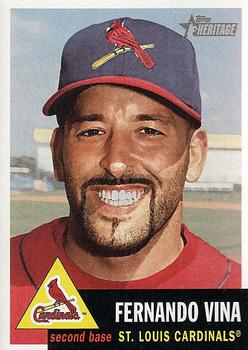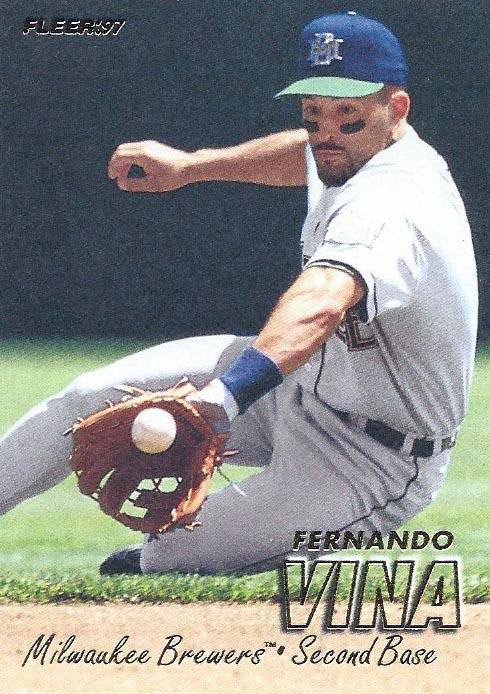Fernando Viña
 Fernando Viña’s story could easily have been quite different. Instead of a 13-year major league career, he could have played in the Cuban Serie Nacional.1 Rather than the red, white, and blue US uniform, he could have donned the burgundy Cuban threads. He could have played with Lourdes Gurriel, Omar Linares, and Germán Mesa in Havana and not against them. But in any parallel universe, Viña would have been a baseball player.
Fernando Viña’s story could easily have been quite different. Instead of a 13-year major league career, he could have played in the Cuban Serie Nacional.1 Rather than the red, white, and blue US uniform, he could have donned the burgundy Cuban threads. He could have played with Lourdes Gurriel, Omar Linares, and Germán Mesa in Havana and not against them. But in any parallel universe, Viña would have been a baseball player.
Viña was born on April 16, 1969 in Sacramento, California, to Cuban émigrés Andrés and Olga Viña, who fled Cuba in 1968 after living under Fidel Castro’s regime for almost a decade.2 The third time proved to be the charm for the couple, whose previous two attempts to escape were thwarted.3 Olga (pregnant with Fernando), Andrés, and their two children took a boat in search of the liberty they were denied. After landing in Key West, the family moved to the west coast, where Fernando’s uncle Carlos worked in a lumber mill. Andrés soon joined his brother at the mill.4
Nicknamed “Nando” and “Ferdie” by his family, Viña soon fell in love with baseball and idolized Cuban Bert Campaneris, the longtime Oakland A’s shortstop, though he preferred the San Francisco Giants. “As a kid, I would watch these games on TV, because I learned, and at night I would just dream and pray about being a major league baseball player.”5 Carlos Viña recalled, “Since he (Fernando) was a little child, he had a plastic bat. Boom! He could hit that ball. I guess it (baseball) is in his blood.”6
The apple did not fall far from the tree. Andrés, a taxi driver by profession, had played in Cuba. Fernando’s brother Jorge played high school and college baseball, and his sister Ana was skilled at softball. Andrés never missed his son’s American Legion games. Viña’s dedication stemmed from “My two idols: my mom and my dad, who gave me that work ethic…and it continued for my whole life through my career in baseball.”7 A man of faith, he credits “Jesus Christ, who has guided my family and me since day one and throughout our journey.”8
Viña excelled at baseball at Valley High School and was a three-time All-League and All-City shortstop. By then 5-foot-9 and 170 pounds, a left-handed hitter but a right-handed thrower, he graduated in 1987 and enrolled at Consumnes River College. After hitting a state-leading .530, he transferred to Sacramento City College. The New York Yankees selected him in the 51st round of the 1988 amateur draft but he opted to return to school.
In 1989, Viña visited Cuba with Team USA to play a short series. He noted, “it was tough to go back, because of my mom and dad and the way they came here, and the situation in Cuba, the communist country it is and how they treat their people, no food or medicine…but I was able to see where my parents grew up, the garage where they lived…I hope someday they (Cubans) can turn it (the political situation) around.”9 He was able to meet relatives, including his aunt, who had remained on the island.
Viña received a full scholarship and transferred to Arizona State University, a perennial college baseball powerhouse. Coach Jim Brock and his wife Patsy visited the Viña household to convince both Fernando and his parents about the opportunity. Jim Woodward scouted the middle infielder; impressed by Viña’s .387 average (tops in the Pac-10) and plate discipline (seven strikeouts in 279 at-bats), he convinced the New York Mets to select the 21-year-old in the ninth round of the 1990 draft. Vina, who had suffered torn ligaments and a fractured pinky in a NCAA Super Regional game against Oklahoma State, had surgery on his hand before reporting to Port St. Lucie for the Fall Instructional League.
In 1991, Viña was solid with Class-A Columbia of the South Atlantic League. In 129 games, he slashed .271/.344/.378 and was promoted to Class-A Advanced St. Lucie of the Florida League in 1992, where he produced similar numbers (.295/.347/.361). He was 6-for-30 in a cup of coffee with Triple-A Tidewater. However, the organization did not include him on the 40-man Mets roster. The Seattle Mariners drafted Viña in the Rule 5 Major League draft on December 7, 1992, but he did not see action in their farm system.
Viña credited many coaches for his progress. “John Tamargo, a Cuban-born manager with the Mets, was a big help for me coming up…teaching me how to be a player, how to be a team player, how to do things the right way and know my role as an infielder. Sam Perlozzo was a huge influence in my life. Jim Brock at Arizona State, Jerry Weinstein, Clint Hurdle…these guys were awesome.”10
Invited to spring training, Viña made the Mariners’ 1993 Opening Day roster, a vertiginous jump from Class-A: “All of a sudden, I’m in a clubhouse with Ken Griffey Jr., who helped me tremendously.”11 Viña debuted at home on April 10 against the Orioles. Down 5-3, Dave Valle led off the bottom of the ninth inning with a single to center. Viña ran for Valle but was forced out on an Omar Vizquel grounder to Cal Ripken.
Viña again pinch-ran for Valle the next day, this time in the eighth inning of a 5-5 game. He was stranded on the bases but took the field in the ninth. Baltimore took the lead on a Brady Anderson home run, but the Mariners evened the score on a Tino Martinez RBI double. Viña struck out to start the 10th but led off the 12th with a double off Mark Williamson for his first major-league hit. Viña scored the winning run minutes later on Jay Buhner’s bases-loaded single.
Viña appreciated manager Lou Piniella, his first big-league skipper: “He gave me a chance as a rookie…playing for him was awesome. It was tough and pressure-packed.” Shortstop Vizquel took Viña under the learning tree, much like Ozzie Smith would do years later with Cardinals.
By early June, Viña was hitting .222; he was returned to the Mets on June 15. New York assigned him to Triple-A Norfolk, where he struggled at the plate (.230/.258/.321) in 73 games. Despite his subpar Triple-A experience, Viña made the Mets’ Opening Day roster in 1994 and was befriended by Dwight Gooden, the last link to the 1986 World Champions.
Despite appearing in only 79 games, Viña was hit by a pitch 12 times, tops in the NL, and reached base 37 percent of the time. The club sent him back to Norfolk during the strike, but he played just six games after being hit on the right ankle by an errant pitch.
The Mets swapped Viña and Javier González to the Milwaukee Brewers for reliever Doug Henry during the offseason. Although the trade was announced on November 30, Viña – a “player to be named later” – was not identified until December 22. With barely a hundred games under his belt, he was now on his third big-league team.
Viña welcomed the change: “Milwaukee was a great opportunity for me to play every day and for another great manager, Phil Garner. I was able to make the best of it. We didn’t win much but we had a good team with Greg Vaughn, Jeff Cirillo, José Valentín, (Mike) Matheny, Dave Nilsson, John Jaha.”12 Finally a regular, Viña played 113 games in 1995 and hit .257/.327/.361.
 Viña’s confidence grew in 1996. Although a hamstring injury hampered his spring training, he was among the most productive middle infielders in the AL in the first half (.312/.376/.434). He credited “a lot of work at the (hitting) tee” as he “spread out his stance to “see the ball better.”13 With the small-market Brewers, he was typically under the radar, but a May 31 play brought national attention.
Viña’s confidence grew in 1996. Although a hamstring injury hampered his spring training, he was among the most productive middle infielders in the AL in the first half (.312/.376/.434). He credited “a lot of work at the (hitting) tee” as he “spread out his stance to “see the ball better.”13 With the small-market Brewers, he was typically under the radar, but a May 31 play brought national attention.
On a routine Eddie Murray ground ball to the right side of the infield, runner Albert Belle viciously tackled Viña. The likely double play was thwarted and Viña escaped injury. Although some words were exchanged, the volatile Belle did not escalate the situation further until the ninth inning, when he was beaned in his last at-bat and a brawl ensued.
Viña was spectacular in the Brewers’ 15-4 drubbing of the Texas Rangers on September 12. He hit two home runs (a career-high), a triple, and two singles for his first five-hit game. (Three other five-safety games would follow, in 1998, 2000, and 2001.) He increased his batting average to .283 in 140 games and led AL second basemen in double plays, putouts, errors, and range factors (per game and per nine innings).
In 1997, Viña fractured his left ankle while attempting to steal second base. The injury sidelined him for three months, and he was limited to 79 games with the Brewers and nine minor-league rehab assignment contests.
Viña and the Brewers moved to the National League in 1998, a style he felt “better suited…the play is a little quicker, a little more aggressive.”14 His plate discipline (.418 OBP in 25 March/April games) showcased a patience the team sought for its leadoff hitter. Though he cooled to .375 by mid-July, he was chosen as the club’s sole All-Star: “I think my defense helped to get me here. I was just hoping it all would work out, and it did. I think I’m playing well enough to be ranked among the best second basemen.”15 By the break, he had committed only four errors. The Sporting News noted “Viña plays hard and is the best second baseman in baseball at turning the double play.”16
In the Midsummer Classic, he laced a single off Rolando Arrojo in the sixth inning and walked off Tom Gordon in the eighth but was thrown out by Paul O’Neill at home on a Devon White single to shallow left field. With such recognition came suitors: Atlanta, Anaheim, Cincinnati, Cleveland, Houston, Toronto, and the Mets were rumored to covet Viña.
For the year, he slashed .311/.386/.427 (114 OPS+) with 22 stolen bases, 39 doubles, 198 hits, 54 walks, 101 runs scored, and 159 games, all career highs. His 25 HBPs placed second in the league, and he paced NL second basemen with 404 putouts, 468 assists, and 135 double plays.
Injuries plagued Viña in 1999. Injuries to his quadriceps, knee, and hamstring – all in his left leg — limited him to 37 games for the Brewers. His offense regressed to .266/.339/.331. After the season, the Brewers traded Viña to the St. Louis Cardinals for Juan Acevedo, Eliezer Alfonzo, and Matt Parker. “At that point… we had good years with Milwaukee but couldn’t get over the hump…so I was excited to be able to go to a winning team…I was all-in. I’ll never forget Stan Musial, Red Schoendienst, Lou Brock, Bob Gibson…so many names that would be around us in spring training. It was a great place to play and the fans were special.”17 Viña was “thankful to manager Tony La Russa and general manager Walt Jocketty, who pushed hard for the trade. La Russa was one of a kind, a flawless motivator. He meant so much to me both on and off the field.”18
Despite missing time with a strained right hamstring and bruised ribs, Viña had a banner season in 2000. In 123 games, he slashed .300/.380/.398, led the NL with 28 HBP, and topped second sackers with a .988 fielding percentage. He also connected for the first inside-the-park home run in Pacific Bell Park’s history on May 9 off Russ Ortiz in a 13-6 Cardinals win over the Giants, with father Andrés in attendance.19 He also took rookie Albert Pujols under his wing and the two became close friends.
The Sporting News lauded his play: “Viña has clearly become one of the game’s top leadoff men. He always has been a good hitter at the top of the lineup, but now he is taking more walks than ever, and his mental approach is sound. He can take a first-pitch strike and not feel as if he is behind. He will take a pitch off his body to help the team. He is extremely good at turning his shoulder to absorb a pitch without making it look as if he wanted to be hit.”20
In his eighth big-league campaign, Viña finally tasted the postseason. He went 4-for-15 in the Cardinals’ LDS sweep of the Braves but struggled (6-for-23) in the LCS against the Mets.
Viña won his first Gold Glove in 2001 and topped the Senior Circuit’s second basemen in fielding percentage for the second straight season. He credited George Kissell, the “father of the Cardinal Way,” and coach José Oquendo for this growth as a defensive player. In 154 games, he improved his average to .303 and his slugging to .418. On October 2, Viña hit the first inside-the-park home run at Miller Park, one of his career-high nine round-trippers. He hit .316 (6-for-19) in the LDS but St. Louis lost to Arizona.
The firmly established fan favorite branched into the entertainment world. Wearing his Cardinals uniform, he appeared in the video for “Welcome to Atlanta (coast 2 coast remix),” a hip-hop collaboration by Jermaine Dupri, Ludacris, and the St. Lunatics (Nelly, Ali, Murphy Lee, Kyjuan, City Spud, and Slo Down).21 The cameo was planned: “Nelly would come hang out with me in the clubhouse and afterwards we’d go to the restaurant across the street. One day they were filming a video at Busch…we had a night game that day, so we filmed the video in the morning.”22 The artists all sported Cardinals home white uniforms with Viña’s name and number on the back.
Vina won a second Gold Glove in 2002, though it would be his last season with more than 100 games. In the ultimate 21st century tribute, the Cardinals hosted a July bobblehead night and 30,552 dolls of Vina’s likeness were gobbled up by Cardinals fans.23 In an LDS rematch against the Diamondbacks, he was exceptional at the plate with a 1.225 OPS but cooled significantly against San Francisco in the LCS (6-for-23).
A torn tendon in his right hamstring, suffered in late May, limited Viña to 61 contests in 2003 and a subpar .251 average, his worst since 1994. He became a free agent on November 3 and signed with Detroit on December 19.
Though Viña began 2004 with high hopes, he strained that same right hamstring on May 12 and missed the remainder of the season. In 29 contests, he hit only .226. He sat out the 2005 season to nurse his injuries. Invited to spring training in 2006 by the Mariners, he managed one hit in 12 at-bats and retired.
Viña appeared in 21 postseason games with the Cardinals. His .333/.364/.430 slash line surpassed his regular-season totals but St. Louis did not reach the World Series until the year after he left the franchise. Playoff baseball was a different experience: “You’d be done and sitting in the clubhouse and you couldn’t even really move…I’ll never forget sitting in there with Will Clark after we had played a playoff game and you just sit there and talk baseball for three hours just to calm down.”24
Viña retired with 1,196 hits, 627 runs scored, and a .348 OBP in 1,148 major league games. He feasted on David Cone (10-for-16), Chan Ho Park (7-for-15), and Miguel Batista (7-for-12) but could not figure out Hideo Nomo (0-for-17), José Lima (5-for-29), and Kirk Rueter (4-for-27). In 97 lifetime at-bats against 3,000-strikeout club members Greg Maddux, Pedro Martínez, Roger Clemens, Randy Johnson, John Smoltz, and Curt Schilling, Viña fanned merely 12 times. Only twice in his major-league career did he strike out three times in a game.
As of the conclusion of the 2024 season, he ranked 21st in career HBP (157) and 71st among all-time second sackers in fielding percentage. His 5.29 range factor per nine innings as a second baseman is 36th all-time, ahead of Hall of Famers Craig Biggio and Roberto Alomar, his contemporaries. Viña is eighth among Sacramentans in games played, and sixth in runs scored and hits.
Named in the Mitchell Report, in 2007 Viña admitted to HGH usage four years previously to recover from injuries – but denied purchasing steroids from former New York Mets clubhouse attendant Kirk Radomski: “I tried everything rehabbing…I came to a point I was desperate. For me, it was to try to get back on the field. That’s the bottom line. Was it right? No, obviously, it was wrong…I’m embarrassed by it.”25
Viña worked for ESPN after his retirement as an analyst for Baseball Tonight. The experience exposed him to “another side of the game, to talk about the why and what of the game, and to explain the how, the little things of the game to the fans out there.”26 He was inducted into the Arizona State University Hall of Fame (2011), the Milwaukee Brewer Wall of Honor (2014), and the Sacramento Sports Hall of Fame (2025).272829
Viña lives in Stateline, Nevada (Lake Tahoe area) and provides baseball lessons via the Major League Baseball Alumni Association. He enjoys the opportunity to “teach the youngsters these days everything I learned and give back to not only the game, but the kids and transfer what I learned from different guys in my career.”30
His son Jordan (from a relationship at a young age; Vina remains unmarried) is also a volunteer baseball coach, with California State University-San Marcos (in addition to serving as a police officer in San Diego). Jordan played two seasons with Sacramento City College and later transferred to Eastern New Mexico University.31
At the opening of the 2025 Auburn, California Little League season, the elder Viña exhorted the youngsters to “continue to work hard, have fun and always dream because you have a chance. We can all be what we want to be in this life. We just have to continue to work hard and have a dream. It’s a blessing to be able to be out here with the kids, and for them to be part of Auburn Little League is just a special experience with so much great support.”32 The American dream begun in 1969 thus continues.
Last revised: June 23, 2025
Acknowledgments
Special thanks to Fernando Viña for graciously agreeing to an interview with the author.
This biography was reviewed by Rory Costello and Bill Lamb and fact-checked by Dan Schoenholz.
Photo credits: Fernando Viña, Trading Card Database.
Sources
Besides the sources listed in the References, the author consulted baseballreference.com, retrosheet.org, and thebaseballcube.com.
Notes
1 Viña played 12 years in the major leagues. He retired after spring training with the Tigers on his 13th year.
2 Author’s interview with Fernando Viña, April 30, 2025.
3 “Fernando Viña,” Sacramento Sports Hall of Fame, https://www.sacsportshof.com/fernando-vina
4 “138. MLB All Star Fernando Vina,” The Jim on Base Show, YouTube, July 4, 2023, https://www.youtube.com/watch?v=Rb6d9qZ9FtI
5 “138. MLB All Star Fernando Vina,” The Jim on Base Show.
6 Bob Sylva, “Far from Home, He Still Hopes for Cuba,” Sacramento Bee, January 10, 1998: B1.
7 “138. MLB All Star Fernando Vina,” The Jim on Base Show.
8 Author’s interview with Fernando Viña, April 30, 2025.
9 “138. MLB All Star Fernando Vina,” The Jim on Base Show.
10 Author’s interview with Fernando Viña, April 30, 2025.
11 Author’s interview with Fernando Viña, April 30, 2025.
12 “138. MLB All Star Fernando Vina,” The Jim on Base Show.
13 Drew Olson, “A.L. Central: Milwaukee Brewers,” The Sporting News, June 3, 1996: 34.
14 “The Book on Fernando Vina,” The Sporting News, May 11, 1998: 28.
15 Nick Peters, “Local Duo Find Themselves on Baseball’s Biggest Stage,” Sacramento Bee, July 7, 1998: D3.
16 Drew Olson, “Milwaukee: D’Amico injury pushes return back to August,” The Sporting News, July 13, 1998: 35.
17 “138. MLB All Star Fernando Vina,” The Jim on Base Show.
18 Author’s interview with Fernando Viña, April 30, 2025.
19 Now Oracle Park, the stadium was originally named Pacific Bell Park
20 Rick Hummel, “St. Louis: Changeup, good health make Stephenson a big winner,” The Sporting News, June 5, 2000: 50.
21 “138. MLB All Star Fernando Vina,” The Jim on Base Show.
22 “138. MLB All Star Fernando Vina,” The Jim on Base Show.
23 Matt Crossman, “Bobblehead night: 80 minutes of madness,” The Sporting News, July 29, 2002: 13.
24 “138. MLB All Star Fernando Vina,” The Jim on Base Show.
25 “ESPN Analyst Vina says he used HGH in 2003, but never steroids,” ESPN.com, December 17, 2007, https://www.espn.com/mlb/news/story?id=3158744
26 Author’s interview with Fernando Viña, April 30, 2025.
27 “Sun Devil Hall of Fame,” Arizona State University, https://thesundevils.com/sports/2000/8/16/208252919.aspx
28 “Milwaukee Brewers Wall of Honor,” Milwaukee Brewers, https://www.mlb.com/brewers/ballpark/attractions/wall-of-honor
29 “Fernando Viña,” Sacramento Sports Hall of Fame.
30 “138. MLB All Star Fernando Vina,” The Jim on Base Show.
31 “Jordan Viña Coach Profile,” California State University, San Marcos Website, https://csusmcougars.com/sports/baseball/roster/coaches/jordan-vina/963
32 Jordan Georgesson, “Play Ball: Auburn Little League Hosts Opening Ceremonies,” Gold Country Media, March 31, 2025, https://goldcountrymedia.com/news/324619/play-ball-auburn-little-league-hosts-opening-ceremonies/
Full Name
Fernando Viña
Born
April 16, 1969 at Sacramento, CA (USA)
If you can help us improve this player’s biography, contact us.

